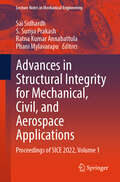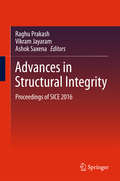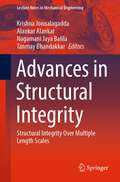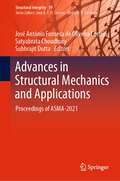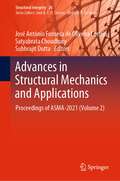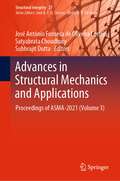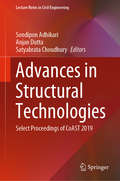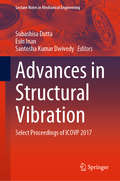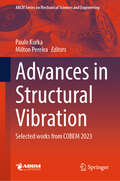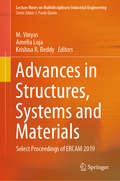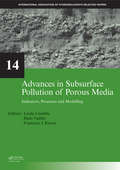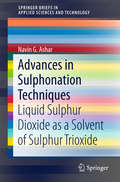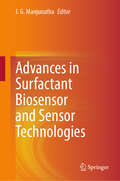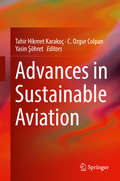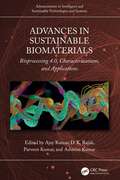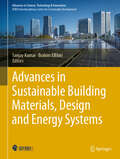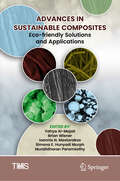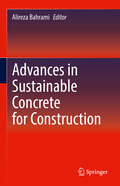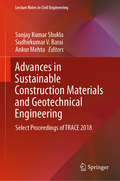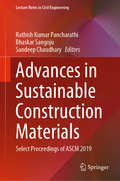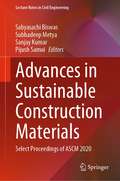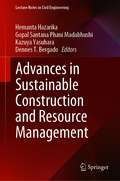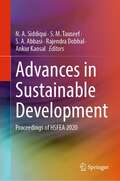- Table View
- List View
Advances in Structural Integrity for Mechanical, Civil, and Aerospace Applications: Proceedings of SICE 2022, Volume 1 (Lecture Notes in Mechanical Engineering)
by Phani Mylavarapu Sai Sidhardh S. Suriya Prakash Ratna Kumar AnnabattulaThis book presents select proceedings of the 4th Structural Integrity Conference and Exhibition (SICE-2022), organized at the Indian Institute of Technology, Hyderabad. This book includes chapters written by eminent scientists and academicians broadly working in aerospace, civil, and mechanical and materials engineering within the areas of structural integrity, life prediction, and condition monitoring. These chapters are classified under the domains of aerospace, fracture mechanics, fatigue, civil structures, experimental techniques, computation mechanics, molecular dynamics and nanostructures, smart materials, energy impact, dynamics, mechanisms, structural optimization, composites, AI/ML applications, additive and advanced manufacturing, bio-engineering, structural health monitoring, nondestructive testing, and damage and failure analysis. The book can be a valuable reference for researchers, students and practicing engineers.
Advances in Structural Integrity: Proceedings of SICE 2016
by Raghu Prakash Vikram Jayaram Ashok SaxenaThis book includes selected technical papers presented at the First Structural Integrity Conference and Exhibition (SICE-2016). The papers, by eminent scientists and academicians working in the areas of structural integrity, life prediction, and condition monitoring, are classified under the domains of: aerospace, fracture mechanics, fatigue, creep-fatigue interactions, civil structures, experimental techniques, computation mechanics, polymer and metal matrix composites, life prediction, mechanical design, energy and transport, bio-engineering, structural health monitoring, nondestructive testing, failure analysis, materials processing, stress corrosion cracking, reliability and risk analysis. The contents of this volume will be useful to researchers, students and practicing engineers alike.
Advances in Structural Integrity: Structural Integrity Over Multiple Length Scales (Lecture Notes in Mechanical Engineering)
by Krishna Jonnalagadda Alankar Alankar Nagamani Jaya Balila Tanmay BhandakkarThis book comprises the proceedings of the 3rd Structural Integrity Conference and Exhibition (SICE 2020). The contents of the volume focus on structural integrity, life prediction, and condition monitoring which are reclassified under the domains of aerospace, fracture mechanics, fatigue, creep-fatigue interactions, civil structures, experimental techniques, computation mechanics, structural health monitoring, nondestructive testing, failure analysis, materials processing, stress corrosion cracking, reliability and risk analysis. This book will be a useful reference for students, researchers and practitioners.
Advances in Structural Mechanics and Applications: Proceedings of ASMA-2021 (Structural Integrity #19)
by Satyabrata Choudhury Subhrajit Dutta José António Fonseca de Oliveira CorreiaThe proceedings of the conference is going to benefit the researchers, academicians, students and professionals in getting enlightened on latest technologies on structural mechanics, structure and infrastructure engineering. Further, work on practical applications of developed scientific methodologies to civil structural engineering will make the proceedings more interesting and useful to practicing engineers and structural designers.
Advances in Structural Mechanics and Applications: Proceedings of ASMA-2021 (Volume 2) (Structural Integrity #26)
by Satyabrata Choudhury Subhrajit Dutta José António Fonseca de Oliveira CorreiaThe proceedings of the conference is going to benefit the researchers, academicians, students and professionals in getting enlightened on latest technologies on structural mechanics, structure and infrastructure engineering. Further, work on practical applications of developed scientific methodologies to civil structural engineering will make the proceedings more interesting and useful to practicing engineers and structural designers.
Advances in Structural Mechanics and Applications: Proceedings of ASMA-2021 (Volume 3) (Structural Integrity #27)
by Satyabrata Choudhury Subhrajit Dutta José António Fonseca de Oliveira CorreiaThe proceedings of the conference is going to benefit the researchers, academicians, students and professionals in getting enlightened on latest technologies on structural mechanics, structure and infrastructure engineering. Further, work on practical applications of developed scientific methodologies to civil structural engineering will make the proceedings more interesting and useful to practicing engineers and structural designers.
Advances in Structural Technologies: Select Proceedings of CoAST 2019 (Lecture Notes in Civil Engineering #81)
by Sondipon Adhikari Anjan Dutta Satyabrata ChoudhuryThis book comprises select proceedings of the National Conference on Advances in Structural Technology (CoAST 2019). It brings together different applied and technological aspects of structural engineering. The main topics covered in this book include solid mechanics, composite structures, fluid-structure interaction, soil-structure interaction, structural safety, and structural health monitoring. The book also focuses on emerging structural materials and the different behavior of civil, mechanical, and aerospace structural systems. Given its contents, this book will be a useful reference for researchers and practitioners working in structural safety and engineering.
Advances in Structural Vibration: Select Proceedings of ICOVP 2017 (Lecture Notes in Mechanical Engineering)
by Subashisa Dutta Santosha Kumar Dwivedy Esin InanThis book consists of selected and peer-reviewed papers presented at the 13th International Conference on Vibration Problems (ICOVP 2017). The topics covered in this book include different structural vibration problems such as dynamics and stability under normal and seismic loading, and wave propagation. The book also discusses different materials such as composite, piezoelectric, and functionally graded materials for improving the stiffness and damping properties of structures. The contents of this book can be useful for beginners, researchers and professionals interested in structural vibration and other allied fields.
Advances in Structural Vibration: Selected works from COBEM 2023 (Lecture Notes in Mechanical Engineering)
by Paulo Kurka Milton PereiraThis book is a compilation of selected works presented at COBEM 2023, emphasizing the field of dynamics and vibrations. It showcases a diverse array of cutting-edge research, ranging from the investigation of metastructures for vibration attenuation in crankshafts to the application of metamaterials for reducing wind tower vibrations. Each chapter offers unique insights and advancements in structural dynamics and vibrations. With contributions encompassing experimental investigations, analytical studies, and practical applications, this book is an invaluable resource for researchers, engineers, and practitioners in the field.
Advances in Structures, Systems and Materials: Select Proceedings of ERCAM 2019 (Lecture Notes on Multidisciplinary Industrial Engineering)
by Krishna R. Reddy M. Vinyas Amelia LojaThis book comprises select peer-reviewed papers from the International Conference on Emerging Research in Civil, Aeronautical and Mechanical Engineering (ERCAM-2019). The contents focus on the latest research trends in engineering materials, mechanics, structures and systems. A wide variety of interesting problems in civil, aeronautical and mechanical engineering have been addressed in this book through various experimental, numerical and analytical methods. The topics covered also provide insight into the challenges prevailing in the aforementioned engineering domains and the potential solutions to address those. Given the contents, the book is a valuable resource for students as well as researchers.
Advances in Subsurface Pollution of Porous Media - Indicators, Processes and Modelling: IAH selected papers, volume 14 (IAH - Selected Papers on Hydrogeology)
by Lucila Candela Francisco Javier Elorza Iñaki VadilloAdvances in Subsurface Contamination of Porous Media: Indicators, Processes and Modelling provides a high level understanding of the processes concerning common and emergent contaminants through their passage from soil to groundwater. The book presents new methodologies and indicators to reach a better understanding of biogeochemical proc
Advances in Sulphonation Techniques: Liquid Sulphur Dioxide as a Solvent of Sulphur Trioxide (SpringerBriefs in Applied Sciences and Technology #151)
by Navin G. AsharThis book presents a complete, in-depth analysis for on the impact of liquid sulfur dioxide and liquid sulfur trioxide to carry out complex and difficult sulfonations, as well as manufacture of sulfuric acid with a CAPEX requirement of less than half, an area requirement less than one-third, and no emission of sulfur dioxide. The processes described in this volume represents an innovative approach relevant to the current manufacturing processes of sulfuric acid, sulfamic acid, para toluene sulfonic acid and other sulfonated product.
Advances in Surfactant Biosensor and Sensor Technologies
by J. G. ManjunathaThis book presents an overview of the development and applications of surfactant biosensor technologies. The progress in this field is fueled by a need for efficient, low cost, stable sensors that utilize harmless materials; this book illustrates how surfactant sensors represent a timely solution to this issue. Readers will learn how to utilize surfactants to make green electrochemical sensors with high stability, sensitivity, selectivity, and a robust, fast response, with special emphasis given to the most recent advances in this field. The book additionally details how to apply these sensors in routine analyses authored by experts in their respective fields. Contributing authors pay close attention to the use of surfactant-based electrochemical sensors in electrodes and devices, examining their applications towards a variety of medicinal, industrial, and environmental applications. This book is an important resource for scientific researchers both specifically in the electrochemistry field, and also for those in interdisciplinary chemistry, biology, physics, and electronics fields. It invites scientists from all areas to participate, with the goal of producing more researchers developing innovative sensor technologies. It will also be beneficial for students and future scientists working on sustainable sensors.
Advances in Sustainable Aviation
by C. Ozgur Colpan Tahir Hikmet Karakoç Yasin ŞöhretThis book provides different engineering, management, economic solutions and methodologies regarding sustainable aviation, giving readers a great sense of how sustainable aviation works at the "systems" level. The aviation industry is one of the fastest growing in the world and can make a positive contribution to sustainability. This book presents environmental policies and their application to the aviation industry and evaluates solutions provided to address pollution. Chapters discuss novel technologies that the aviation industry can apply to reduce its environmental impact and become more energy efficient.
Advances in Sustainable Biomaterials: Bioprocessing 4.0, Characterizations, and Applications (Advancements in Intelligent and Sustainable Technologies and Systems)
by Ajay Kumar Parveen Kumar Ashwini Kumar D. K. RajakSustainable biomaterials are used as substitutions for traditional materials in aerospace, automotive, civil, mechanical, environmental engineering, medical, and other industries. This book presents the current knowledge and recent developments on the characterization and application of sustainable biomaterials with biomanufacturing 4.0 techniques. The book also describes the unique properties of various classes of sustainable biomaterials, making them highly suitable for many industrial applications.Advances in Sustainable Biomaterials: Bioprocessing 4.0, Characterizations, and Applications presents key chapters on smart biopolymer composites production and processing methods and provides a wide range of applications in a variety of fields such as medical, food, agriculture, electronics, manufacturing, and chemical engineering. The book features the most recent and detailed information on advancements in biopolymer biomaterials and emphasizes synthesis, characterization, modeling, manufacturing, and testing strategies.Written to be used as a resource guide on biomaterials and innovations, undergraduate and postgraduate students studying manufacturing and materials science will find this book very useful in addition to those working in mechanical engineering, biomedical engineering, manufacturing of pharmaceuticals, biotechnology, and electronics engineering fields. The book can also be used as additional classroom reading for an advanced course on biomaterials modeling and optimization.
Advances in Sustainable Building Materials, Design and Energy Systems (Advances in Science, Technology & Innovation)
by Sanjay Kumar Brahim ElBhiriThis book is a great opportunity to make the research community discuss the dangerous environmental challenges such as climate change and its huge effects in addition to the world's reliance on fossil fuel and non-renewable resources. In recent years, the authors have been focused on the advancements of technology and how it can improve our lives, but the authors often overlook the fact that it is creating an unsustainable approach that comes at a high cost which makes a sustainable approach to cities necessary, focusing on accessible public transport, energy, water, and food security, and regenerating compact fabric areas. To discuss how to reach this sustainable approach, IEREK held the Advances in Energy Research, Materials Science and Built Environment (EMBE) conference from October 3 to 4, 2024, with attendees from all over the world. It provides an opportunity to exchange ideas and solutions on urban planning, sustainable architecture, climate change mitigation, and innovative design. The EMBE conference hosts a variety of knowledgeable keynote speakers and researchers who discussed the integration of technology in sustainable urban planning, green urbanism, preservation of coastal areas, innovative renewable materials, and responsive architecture. The book covers a wide range of scientific knowledge that can lead humanity toward a sustainable and greener future.
Advances in Sustainable Composites: Eco-friendly Solutions and Applications (The Minerals, Metals & Materials Series)
by Simona E. Hunyadi Murph Brian Wisner Ioannis N. Mastorakos Muralidharan Paramsothy Yahya Al-MajaliThis collection covers innovations in the field of composite materials with a specific focus on eco-friendly and environmentally sustainable systems. All composite fields are explored, including polymer, metal, and ceramic matrix composites with an emphasis on sourcing raw materials in a sustainable way as well as the development of composite materials for environmental sustainability. Topics will include the development of new materials for structural applications, reduction in energy consumption, and increased component life along with discussions of novel methods to reuse existing materials. Additional topics include but are not limited to: Naturally sourced materials feedstock Recycled material feedstock Application of composite for reduced carbon footprint Development of novel materials to repurpose waste from other areas Eco-nanomaterials/nanocomposites Selected rapid prototyping.
Advances in Sustainable Concrete for Construction
by Alireza BahramiThis book offers groundbreaking insights into transforming the concrete industry with innovative, environmentally conscious solutions. It explores the latest advancements in sustainable technologies, including climate-improved concrete, green binders, recycled materials, and high-performance composites. It also covers the optimization of reinforced concrete structures, load-bearing columns and beams replacements, as well as non-destructive testing methods for predicting concrete performance. Additionally, it investigates engineered cementitious composites, internally cured concrete, and industrial by-products to address pressing environmental challenges in construction. An indispensable reference for engineers, architects, and researchers shaping the future of sustainable infrastructure and reducing carbon footprints
Advances in Sustainable Construction Materials and Geotechnical Engineering: Select Proceedings of TRACE 2018 (Lecture Notes in Civil Engineering #35)
by Sanjay Kumar Shukla Sudhirkumar V. Barai Ankur MehtaThis book comprises select papers presented at the International Conference on Trends and Recent Advances in Civil Engineering (TRACE 2018). The topics covered include the utilization of industrial by-products as construction materials, sustainable and green materials in construction applications, and latest measures adopted for stabilization techniques. The book also discusses recent advances and techniques related to geotechnical and concrete domain that can be used as a reference guide for various researchers and practitioners around the globe.
Advances in Sustainable Construction Materials: Select Proceedings of ASCM 2019 (Lecture Notes in Civil Engineering #68)
by Rathish Kumar Pancharathi Bhaskar Sangoju Sandeep ChaudharyThis book presents select proceedings of the National Conference on Advances in Sustainable Construction Materials (ASCM 2019) held at the National Institute of Technology, Warangal, India. The book includes contributions from academics and practitioners on low-energy cement technologies, innovative materials and structural technologies towards cost-effective, environment friendly, durable, energy-efficient, and sustainable construction. The topics covered emphasize on cutting-edge, economically viable, and sustainable solutions with an aim to increase profitability, and decrease construction time and overall impact on the built environment. The book will be useful for researchers and practitioners interested in sustainable construction and allied fields.
Advances in Sustainable Construction Materials: Select Proceedings of ASCM 2020 (Lecture Notes in Civil Engineering #124)
by Sanjay Kumar Pijush Samui Sabyasachi Biswas Subhadeep MetyaThis book presents select proceedings of National Conference on Advances in Sustainable Construction Materials (ASCM 2020) and examines a range of durable, energy-efficient, and next-generation construction materials produced from industrial wastes and by-products. The topics covered include sustainable materials and construction, innovations in recycling concrete, green buildings and innovative structures, utilization of waste materials in construction, geopolymer concrete, self-compacting concrete by using industrial waste materials, nanotechnology and sustainability of concrete, environmental sustainability and development, recycling solid wastes as road construction materials, emerging sustainable practices in highway pavements construction, plastic roads, pavement analysis and design, application of geosynthetics for ground improvement, sustainability in offshore geotechnics, green tunnel construction technology and application, ground improvement techniques and municipal solid waste landfill. Given the scope of contents, the book will be useful for researchers and professionals working in the field of civil engineering and especially sustainable structures and green buildings.
Advances in Sustainable Construction and Resource Management (Lecture Notes in Civil Engineering #144)
by Hemanta Hazarika Kazuya Yasuhara Gopal Santana Phani Madabhushi Dennes T. BergadoThis book comprises the proceedings of the 1st International Symposium on Construction Resources for Environmentally Sustainable Technologies. The contents of this volume focus on issues related to natural and man-made disasters, and discuss solutions through the use of alternative resources, towards building a sustainable and resilient society from geotechnical perspectives. Some of the themes covered include recycled materials in geotechnical constructions, management and utilization of disaster wastes, climate change independent natural disasters, socio-economic and environmental aspects in sustainable construction, physical and numerical modelling of disaster mitigation techniques, etc. This book will be beneficial to researchers, practitioners, and policy-makers alike.
Advances in Sustainable Development: Proceedings of HSFEA 2020
by S. M. Tauseef S. A. Abbasi N. A. Siddiqui Rajendra Dobhal Ankur KansalThis book comprises selected papers on advances in the field of health and environment safety that were presented at the International Conference on Advances in the field of Health, Safety, Fire, Environment, Allied sciences and engineering (HSFEA 2020). This book presents a number of research papers which focuses on basic concept of sustainable development and its role in modern world for clean development technology. The book also presents methods that can be used to effectively monitor and measure climate change and global warming. Further, the contents of this work stress the importance of maintaining safety and healthy work environments that are free of occupational health hazards. This book will be of interest to researchers, professionals, and policy makers alike.
Advances in Sustainable Energy (Lecture Notes in Energy #70)
by Ahmad Vasel David S-K. TingThis book reveals key challenges to ensuring the secure and sustainable production and use of energy resources, and provides corresponding solutions. It discusses the latest advances in renewable energy generation, and includes studies on climate change and social sustainability. In turn, the book goes beyond theory and describes practical challenges and solutions associated with energy and sustainability. In particular, it addresses: · renewable energy conversion technologies; · transmission, storage and consumption; · green buildings and the green economy; and · waste and recycling. The book presents the current state of knowledge on renewable energy and sustainability, supported by detailed examples and case studies, making it not only a cutting-edge source of information for experts and researchers in the field, but also an educational tool for related undergraduate and graduate courses.
Advances in Sustainable Energy: Policy, Materials and Devices
by Sajid Bashir Jingbo Louise Liu Yong-Jun Gao Weixin SongThis books provides a comprehensive platform to the scientific, education and research communities working on various fields related to sustainable energy. It covers the exploration, generation and application of this area to meet societal needs as well as addressing global issues related to the environment. The content of this book presents research related to energy and how to tackle climate change as a comprehensive framework based on the success of the Millennium Development Goals (MDGs). The authors use the scientific method to analyze and deliver viable technical solutions, demonstrating how chemistry and engineering can be combined to solve technically challenging problems. While maintaining high scientific rigor, a quantitative approach is offered in select chapters to the study of energy related to our societies increasing need for electrical and chemical energy feedstocks.
